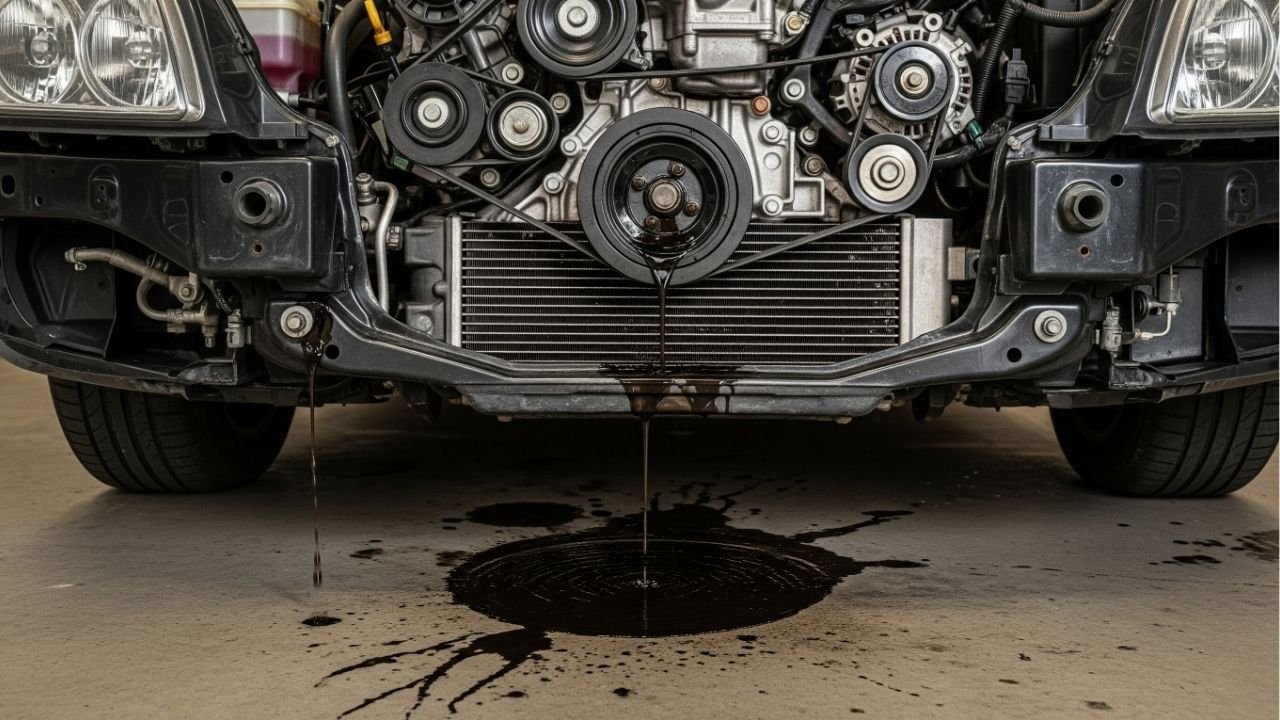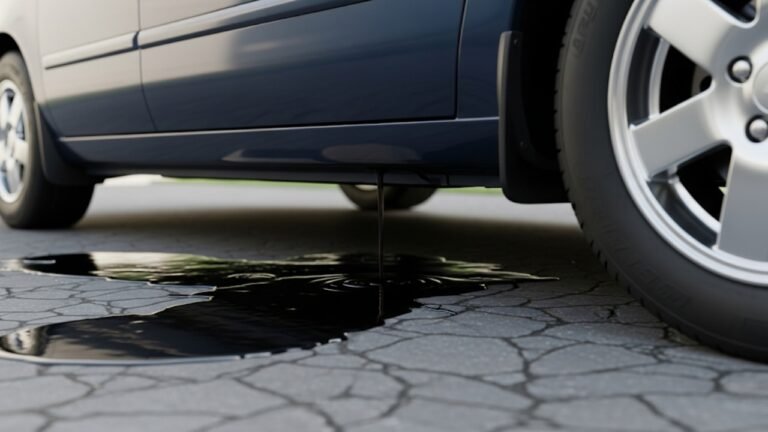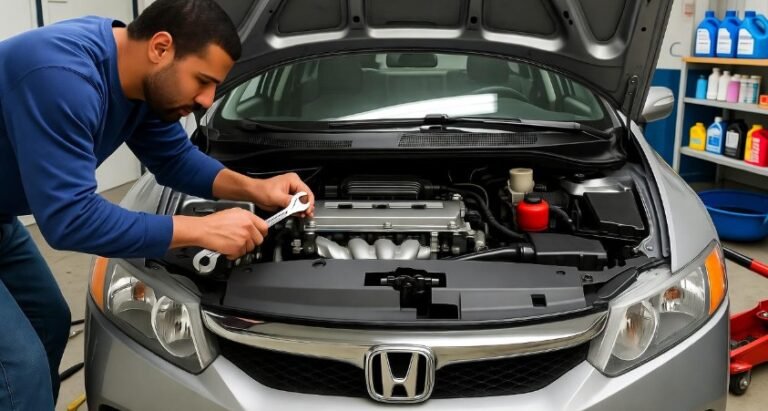Why Is My Car Leaking Oil from the Front?

Have you ever walked up to your car in the morning, only to spot a dark puddle right beneath the front bumper? It’s the kind of moment that makes your stomach drop — a mixture of confusion, worry, and frustration. You ask yourself, “Is this serious? Will my engine blow up? Can I still drive it?”
Well, if you’ve caught yourself thinking “my car is leaking oil from the front,” you’re definitely not alone. It’s one of the most common and alarming issues car owners face, and ignoring it can lead to some serious (and expensive) engine problems.
In this guide, we’ll dive into why your car is leaking oil from the front, what it means, and what you should do about it. We’ll break everything down in simple terms — no jargon, just real talk. From identifying where the leak is coming from to figuring out whether it’s a quick fix or a major repair, we’ve got your back.
Let’s roll up our sleeves and get under the hood, shall we?
In This Article
- 1 Oil Leaking from the Front of My Car: What Does It Mean?
- 2 Why Is Oil Important — And Why a Leak Can Be Dangerous
- 3 The Most Common Reasons for Front-End Oil Leaks
- 4 How to Confirm It’s Engine Oil That’s Leaking
- 5 Can I Still Drive If My Car Is Leaking Oil from the Front?
- 6 What to Do Immediately If You Notice a Leak
- 7 Preventing Future Oil Leaks
- 8 Cost Breakdown: What Will It Take to Fix an Oil Leak?
- 9 DIY or Mechanic: Which Route Should You Take?
- 10 How Oil Leaks Impact Engine Performance Over Time
- 11 The Emotional Side of Oil Leaks (Yes, We’re Going There)
- 12 FAQs About Oil Leaks from the Front of Your Car
- 12.1 1. Can I ignore a small oil leak if it’s not dripping much?
- 12.2 2. Is it safe to drive a short distance if I top off the oil?
- 12.3 3. How long does it take to repair an oil leak?
- 12.4 4. Can weather or temperature changes cause oil leaks?
- 12.5 5. Will using synthetic oil stop the leak?
- 12.6 6. Should I use an oil stop-leak additive?
- 12.7 7. How can I tell if the leak is serious?
- 12.8 8. What color should clean engine oil be?
- 13 Final Thoughts: Don’t Let an Oil Leak Break Your Heart (Or Wallet)
Oil Leaking from the Front of My Car: What Does It Mean?

Here are some common components where front-end oil leaks usually start:
-
Oil pan gasket
-
Timing cover seal
-
Front crankshaft seal
-
Valve cover gasket (if leak flows downward)
-
Oil filter or oil filter housing
-
Loose or damaged drain plug
Many of these parts are near the front of the engine, especially in front-wheel-drive vehicles where engines are mounted sideways. A leak might look like it’s at the front, even if it started elsewhere.
Quick tip: Take a clean white paper towel and dab the oil. If it’s dark and sticky, it’s engine oil. If it’s reddish, it might be transmission fluid. If it’s clear or yellowish, it could be coolant or brake fluid.
Why Is Oil Important — And Why a Leak Can Be Dangerous
Imagine oil as your car’s blood. It flows through every corner of the engine, reducing friction, keeping things cool, and preventing metal parts from grinding each other to death. So, when your engine starts bleeding from the front, you’ve got a problem.
Driving with low or no oil can lead to:
-
Overheating
-
Premature engine wear
-
Catastrophic engine failure
-
Stalling or complete shutdown
That’s why ignoring the issue and hoping it’ll go away is not an option. Even if it’s a slow drip, that oil loss adds up. It can dry out seals, attract dirt, and clog sensors. Worse yet, it could end up costing you thousands in engine repairs.
The Most Common Reasons for Front-End Oil Leaks
Let’s walk through each cause in more detail. Knowing where to look can save you hours of stress — and even help your mechanic diagnose it faster.
1. Worn or Cracked Oil Pan Gasket
The oil pan is located at the bottom of your engine, and the gasket forms a seal between the oil pan and engine block. Over time, heat and vibration can wear it out.
-
Signs: Puddle right under the engine, smell of burning oil, visible seepage on pan edges.
-
Fix: Replace gasket ($100–$350 including labor).
2. Leaking Timing Cover Gasket
Your engine’s timing chain or belt is covered with a metal or plastic housing. If that cover’s gasket fails, oil may leak — especially near the front.
-
Signs: Oil pooling near the front of the engine or under the timing cover, rattling noise from timing chain.
-
Fix: Gasket replacement ($300–$700 depending on vehicle).
3. Bad Front Main Seal (Crankshaft Seal)
This seal surrounds the front end of the crankshaft, keeping oil inside. Age, heat, and crankshaft movement can cause it to crack or shrink.
-
Signs: Oil dripping near the center front of your engine, possibly sprayed on belts or pulleys.
-
Fix: Replace seal ($400–$900 with labor).
4. Loose or Damaged Oil Filter
Changing your oil at home? If the filter isn’t tightened properly, or the gasket sticks from the old one, it’ll leak. Or maybe the filter itself cracked.
-
Signs: Oil trails near the filter, fresh oil dripping shortly after oil change.
-
Fix: Replace oil filter ($10–$50), or tighten it properly.
5. Loose Drain Plug or Worn Washer
That little bolt at the bottom of your oil pan? If it’s not tight enough or the washer’s worn, oil will seep out slowly.
-
Signs: Slow leak right beneath the oil pan.
-
Fix: Tighten plug or replace washer ($5–$25), in severe cases replace plug.
How to Confirm It’s Engine Oil That’s Leaking
Before jumping to conclusions, it’s important to know for sure whether the leak is from engine oil. Here’s how to identify the fluid:
| Fluid | Color | Texture | Smell |
|---|---|---|---|
| Engine Oil | Dark brown/black | Thick, greasy | Slightly burnt |
| Transmission Fluid | Red/pink | Slippery, oily | Sweet or pungent |
| Coolant | Green/orange/yellow | Slick, watery | Sweet, syrupy smell |
| Brake Fluid | Clear to amber | Oily, light | Sharp, chemical |
If your leak is thick and dark, especially with a burnt smell, you’re most likely dealing with engine oil. If it’s coming from the front, you can now confidently say, “My car is leaking oil from the front.”
Can I Still Drive If My Car Is Leaking Oil from the Front?
This is probably the biggest question people ask — and it really depends on the severity of the leak.
Here’s a quick guide:
-
Tiny leak or few drops overnight: Yes, short distances only. Check oil daily.
-
Moderate leak, active dripping: Avoid driving. Tow it or check with a mechanic ASAP.
-
Heavy leak or oil warning light is on: Do not drive. Severe engine damage can occur.
Think of it like this: Would you run a marathon with a bleeding foot? Of course not. So don’t ask your engine to work overtime with low oil.
What to Do Immediately If You Notice a Leak
If you just spotted that puddle and you’re panicking, take a breath. Here’s what to do, step by step:
-
Park on flat, dry ground and check under the engine.
-
Pop the hood and inspect around the oil cap, filter, and pan.
-
Use a dipstick to check the oil level. If it’s low, don’t drive.
-
Take a photo of the leak to show a mechanic.
-
Put cardboard under your car overnight to track the severity and location.
If you’re low on oil but must move the car, top it off with the correct type and drive straight to a repair shop — no detours.
Preventing Future Oil Leaks
Once you fix it, the goal is to never see that stain again, right? Prevention is cheaper than repair. Here’s how to keep your engine tight and leak-free:
-
✅ Stick to your oil change schedule.
-
✅ Use high-quality oil and filters.
-
✅ Don’t overtighten the oil filter or drain plug.
-
✅ Ask your mechanic to inspect seals and gaskets during servicing.
-
✅ Clean engine bay every few months to spot early leaks.
Keeping your engine healthy is like brushing your teeth — do it often and you’ll avoid costly dental… ahem, engine surgery.
Cost Breakdown: What Will It Take to Fix an Oil Leak?
Let’s be real — cost matters. Car repairs can feel like surprise bills you never asked for. But knowing what to expect helps you plan better.
Here’s a handy table to give you an idea of typical repair costs based on the cause of the oil leak:
| Leak Source | Estimated Cost (Parts + Labor) |
|---|---|
| Oil Pan Gasket | $100 – $350 |
| Front Crankshaft Seal | $400 – $900 |
| Timing Cover Gasket | $300 – $700 |
| Oil Filter (replacement) | $10 – $50 |
| Drain Plug or Washer | $5 – $25 |
| Valve Cover Gasket | $150 – $400 |
Pro tip: Prices vary depending on your car’s make, model, and your mechanic’s labor rates. Luxury or performance cars? Expect to pay more.
DIY or Mechanic: Which Route Should You Take?
If you’re a weekend wrench-warrior, you might wonder if you can fix the issue yourself. Here’s a quick comparison to help you decide.
DIY Repair
-
Pros:
-
Cheaper (just pay for parts)
-
Learn valuable skills
-
Instant gratification
-
-
Cons:
-
Risk of doing it wrong
-
Can be messy, especially under the engine
-
May need special tools or ramps
-
Going to a Mechanic
-
Pros:
-
Professional inspection and diagnosis
-
Quality parts and proper torque specs
-
Warranty on work
-
-
Cons:
-
More expensive
-
Might have to wait for parts or appointments
-
When to DIY: If it’s a simple issue like a loose drain plug or oil filter.
When to call a pro: If it involves seals, timing covers, or engine removal.
How Oil Leaks Impact Engine Performance Over Time
An oil leak isn’t just a cosmetic issue. Think of it like a slow poison for your engine. Even if it’s just a few drops a day, the effects pile up.
Here’s what can happen if you let it go too long:
-
Oil starvation: Without enough oil, your engine parts wear out fast.
-
Overheating: Oil helps manage heat. Less oil means higher engine temps.
-
⚠️ Sensor failure: Oil can coat sensors and mess with engine readings.
-
Reduced performance: Dirty, leaking engines run rougher, louder, and less efficiently.
-
Engine seizure: In the worst-case scenario, the engine can lock up completely.
It’s kind of like ignoring a tiny crack in your phone screen. Eventually, the whole screen shatters — and the repair costs triple.
The Emotional Side of Oil Leaks (Yes, We’re Going There)
Car trouble can make you feel helpless. You planned to drive to work or take your kid to school — not spend the day dealing with mechanics. I remember once pulling into a parking lot and seeing a glistening black trail behind my car. My stomach dropped. It felt like my car was crying oil tears.
These moments are frustrating, but they’re also human. The important thing is not to beat yourself up. Catching the leak early is a win. It means you care enough about your ride to prevent worse damage.
FAQs About Oil Leaks from the Front of Your Car
1. Can I ignore a small oil leak if it’s not dripping much?
You can, but you shouldn’t. Even slow leaks get worse over time. Plus, that leak could be damaging other engine parts or attracting dirt and grime. Small now doesn’t mean safe later.
2. Is it safe to drive a short distance if I top off the oil?
Yes, if the leak is slow and you’ve recently added oil. But keep the trip short and monitor your oil level frequently. If the leak is fast or your oil light is on, don’t risk it.
3. How long does it take to repair an oil leak?
It depends. Simple fixes like a loose filter take 15 minutes, while replacing a front crankshaft seal could take 3–5 hours or more. Always ask your mechanic for an estimate.
4. Can weather or temperature changes cause oil leaks?
Absolutely. Cold weather can shrink gaskets and seals, while heat can cause expansion and wear. Rapid temperature swings make old seals more likely to crack or fail.
5. Will using synthetic oil stop the leak?
Some high-mileage synthetic oils contain seal conditioners that help reduce leaks. But they won’t fix major gasket or seal failures. It’s more of a temporary bandage than a cure.
6. Should I use an oil stop-leak additive?
You can try, especially for tiny leaks. But most of these products are short-term fixes. They swell seals temporarily but may gum up other engine components over time.
7. How can I tell if the leak is serious?
If you’re adding oil more than once a week, if there’s visible smoke, or if your engine starts running rough, it’s serious. Also, leaks that hit belts or electrical parts need urgent attention.
8. What color should clean engine oil be?
Fresh engine oil is amber or light brown. If your leaking oil is pitch black, it’s overdue for a change. Darker oil also makes it harder to detect new leaks — so change it regularly.
Final Thoughts: Don’t Let an Oil Leak Break Your Heart (Or Wallet)
If you’ve been thinking, “My car is leaking oil from the front, what do I do?”, take this as your friendly reminder that you’re not alone — and you’re not helpless. Whether it’s a simple filter issue or a gasket that’s seen better days, catching it early can save your engine and your sanity.
Cars are like relationships. They need attention, maintenance, and sometimes, a little patience. That dark puddle might be a warning sign — not a death sentence.
So, check under your hood, get familiar with the signs, and don’t hesitate to call in the pros when it’s needed. You’ve got this.






